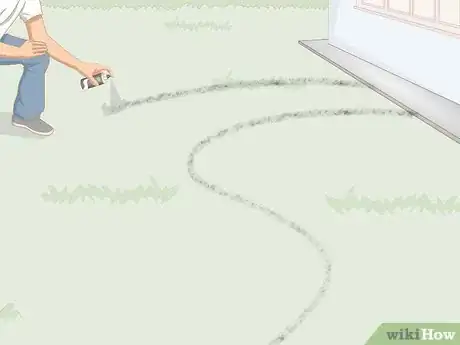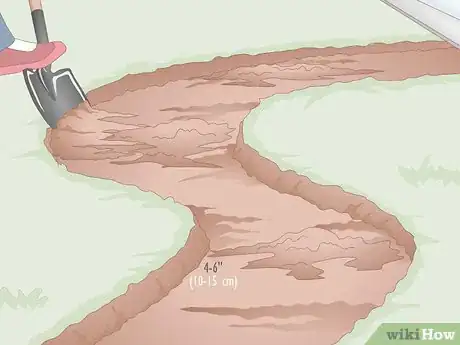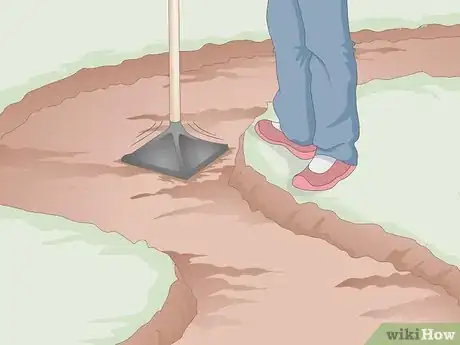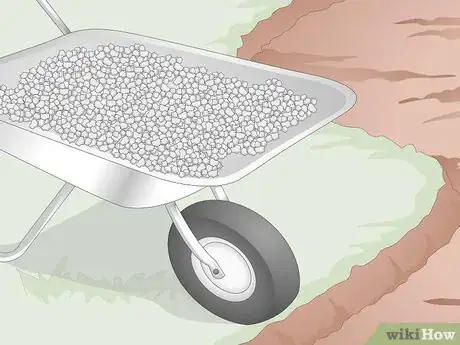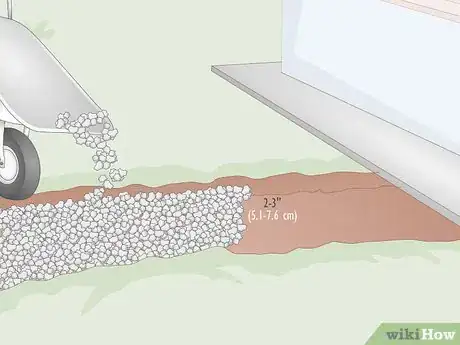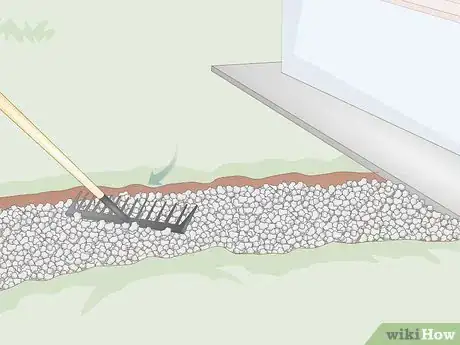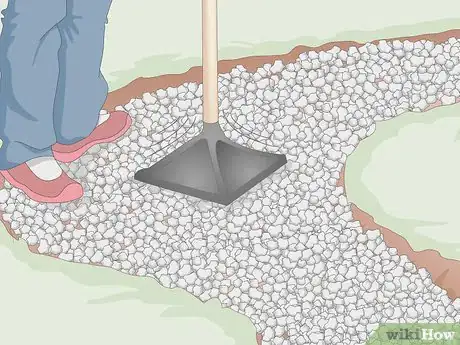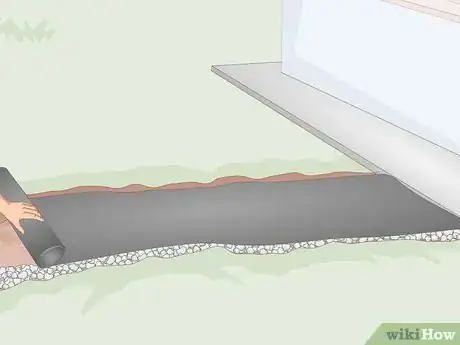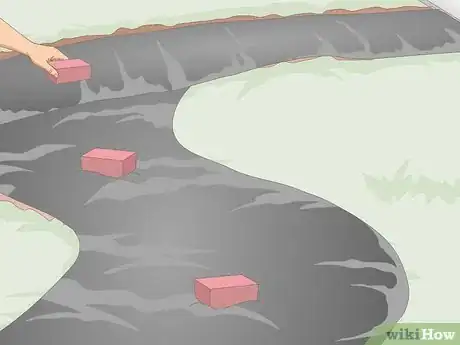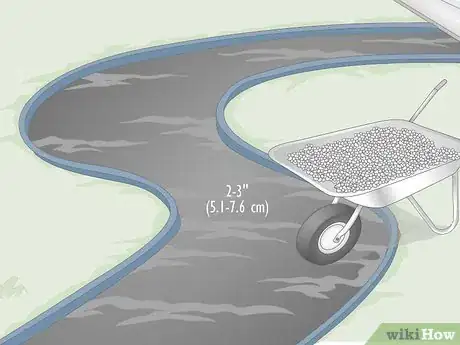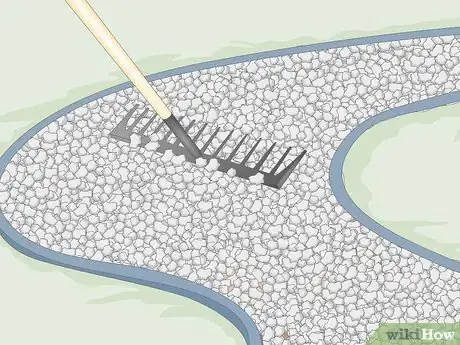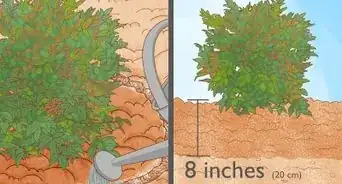This article was co-authored by Alberto DeJesus and by wikiHow staff writer, Eric McClure. Alberto DeJesus is a Construction Specialist and the CEO of DeJesus Industries. With more than four years of experience, he specializes in high-end real estate development and construction. Alberto and DeJesus Industries have been featured on NBC News and have worked with numerous well-known companies, including Mazda, Amazon, and CVS. Alberto holds a Bachelor’s degree from Boston University.
There are 11 references cited in this article, which can be found at the bottom of the page.
This article has been viewed 34,645 times.
Gravel makes a great material for driveways, walkways, and garden borders. It’s easy to move around and doesn’t require a lot of skilled labor to install. In fact, the hardest part of laying gravel is moving and pouring the heavy stone. To lay gravel, mark your area off with spray paint or rope. Then, use a spade to remove 4–6 inches (10–15 cm) of soil. Pour 2–3 inches (5.1–7.6 cm) of crushed stone into the pit and put landscaping fabric on top. Cover the fabric with your gravel and spread it out with a rake to finish laying your gravel. While gathering your materials may take quite some time, it shouldn’t take more than 4-6 hours to actually install your gravel.
Steps
Digging the Soil
-
1Mark the area where you’re going to lay the gravel. Determine where you’re going to place your gravel. Use spray paint, a garden hose, or a length of rope to create guidelines in your soil or grass. Mark off every dimension for your gravel so that you can keep track of what soil you need to remove.[1]
- Gravel is often laid to make a path, walkway, or driveway. It can also be laid decoratively to create some variety in your garden or installed to make a foundation for a free-standing shed.
-
2Use a spade to remove soil to make a pit 4–6 inches (10–15 cm) deep. Get a spade, preferably one with a flat blade. Starting in the center of your pit or path, start digging out your soil. Remove the top 4–6 inches (10–15 cm) of dirt. Dig around the edges of your pit by keeping the spade as vertical as possible to ensure that the edges remain uniform with the rest of the pit.[2]
- You can visually estimate what 4–6 inches (10–15 cm) looks like, or you can use a measuring tape to measure how deep you’ve gone.
Tip: Put the soil that you dig out into a wheelbarrow or on top of a tarp to make it easy to remove.
Advertisement -
3Smooth the soil out with a steel rake to make your foundation even. Get a steel rake with a flat edge on the back of the tines. Use the tines to rip up any uneven areas of soil. Use the flat backside of the rake to shift the loose soil around to make the foundation even and level.[3]
- You can use a flat edge of your spade to shift the soil around if you prefer. It doesn’t really matter how you do this.
-
4Compact the soil with a hand tamper to stabilize the base. Get a hand tamper from your local home supply store. Use the hand tamper to compact the soil by slamming the flat plate into every portion of the soil that you’ve excavated. Compacting the soil will ensure that your pit stays stable and flat over time.[4]
- A hand tamper is a large pole with a flat, metal plate at the bottom. It is used to compress soil and stone so that it doesn’t shift around.
- You cannot use an electric plate compactor for this particular step unless you’re compacting hard clay.
Laying a Stone Base
-
1Get enough crushed stone to fill 2–3 in (5.1–7.6 cm) of your pit. You can order crushed stone from a landscaping company if you want to get it delivered to your home, or buy some yourself at a home supply or construction store. Calculating how much stone you need is kind of tricky. For a general estimate, multiply the length times the width of your pit to get the square footage (or square meters). Then, double this number and compare it to the square footage listed on a bag of crushed stone.[5]
- You can use sand instead of crushed stone if you live in a tropical environment where it rains a lot and gets extremely hot.
- Crushed stone comes in a variety of different forms. Limestone, granite, and marble chips will all work for this process. It doesn’t really matter since you’re only using it as a base.
- For example, if your pit is 6 by 8 feet (1.8 by 2.4 m), multiply 6 ft (1.8 m) by 8 ft (2.4 m) to get 48 sq ft (4.5 m2). Double this number to get 96 sq ft (8.9 m2).
- You can use an online calculator to determine how much stone you need. You can find one of these calculators at http://fredburrows.com/index.php/calculator/.
-
2Line the pit with 2–3 in (5.1–7.6 cm) of crushed stone. Pour your crushed stone directly out of the bag or use a shovel to add it to your pit. Pour enough crushed stone to fill the bottom 2–3 inches (5.1–7.6 cm) of your pit.[6] After you add 1–2 feet (0.30–0.61 m) worth of stone across an area, use a ruler to measure how deep the base is to ensure that you aren’t pouring too much.[7]
- You can always remove excess stone with a shovel or pour more crushed stone into the pit, so don’t worry if you don’t get it perfectly right the first time.
-
3Use your steel rake to spread the stone around and level it out. Once you’ve poured your stone out, use the tines of your steel rake to work the stone around your pit. Use the flat edge of the rake to even the stone out and create a flat surface. If you’d like, use a spirit level to ensure that you’ve spread your stone out evenly across the surface.[8]
- Do your best to keep the stone level around the edges of the pit.[9] Don’t worry if there are a few elevated stones around the edges, though.
-
4Spray the crushed stone with water to soften it up and remove dust. To help the stone settle and keep the dust down, use a garden hose to mist the crushed stone. If you have a spray attachment, use the widest nozzle setting to spread the water out. Otherwise, use your thumb to press down on the end of the hose and widen the angle of the water.[10]
- If you don’t have a hose nearby, you can fill a watering can with water and pour the water over the stone. Refill the can as needed until you’ve completely soaked your stones.
- Too much water is better than too little. You won’t harm anything by getting the pit wet.
-
5Compact the crushed stone with a hand tamper. Once you’ve misted the crushed stone, use your hand tamper to compress the stone. Lift the tamper up and slam it into the stone to compress it. Repeat this process for every section of stone that you’ve laid out. You can use a motorized plate compactor if you prefer.[11]
Tip: Motorized plate compactors look like lawn mowers and use a motor to push a horizontal plate into the ground repeatedly. They’re easier to use than a hand tamper, but you’ll need to rent one from your local home supply store. It will cost $60-200 to rent a motorized plate compactor.
Adding Landscape Fabric
-
1Get enough landscaping fabric to cover the area of your pit. Landscaping fabric is a woven textile material that is used to keep weeds and unwanted plants from growing out of a surface. It also improves drainage and prevents loose stones from shifting. Purchase enough landscaping fabric to cover your pit. You can have it delivered by a landscaping company or purchase it a home supply or gardening store.[12]
- Landscaping fabric is sold in bundles based on the square footage (or square meters) of an area. Use the area of your pit to determine how much landscaping fabric you need.
-
2Spread strips of landscape fabric over your crushed stone. Take your roll of landscaping fabric and roll it out over a section of crushed stone. Use scissors, shears, or a utility knife to cut the landscaping fabric to size. Then, roll another length of landscape fabric next to your first length, overlapping the 4–8 in (10–20 cm) of your first strip’s edge. Repeat this process until you’ve covered your entire pit with landscaping fabric.[13]
- Use bricks or lengths of wood to hold the landscaping fabric in place if it’s a little windy.
-
3Cut relief lines into the edge of the fabric to fit it around round edges. If you have any curved edges, cut a 4–6 in (10–15 cm) line into side of your fabric on the corner where you need it to bend. This will relieve some of the tension in the fabric and make it easier to fit it around your curve. Repeat this process as many times as needed to fit the fabric to the shape of your pit.[14]
- If some of the fabric sticks out past the sides of your pit, use scissors, shears, or a utility knife to trim the excess fabric off.
Tip: Don’t worry if there are some pleats or small openings in the fabric. So long as the majority of your pit is filled and the gaps aren’t particularly big, the fabric will work just fine.
-
4Use bricks to weigh the fabric down and pull it tight. Once your fabric is laid out and all of your round edges are covered, use bricks or lengths of wood to weigh the fabric down around the edges of your pit. Then, gently pull on the ends of the fabric to stretch it out and fit it to the surface of your crushed stone. This will ensure that the fabric stays taut and doesn’t shift your gravel around after it has been poured.[15]
- You can use any heavy item to weigh the fabric down so long as it doesn’t tear the fabric.
-
5Pin the fabric in place using spikes or large pins. To keep the fabric from sliding around, dig spikes or large pins into the fabric to pin it to the ground. Place one spike or pin every 2–4 feet (0.61–1.22 m) around the border of your pit to keep the fabric from shifting. These spikes and pins are usually sold to keep tents and tarps in place, and you can purchase them at any outdoor goods store.[16]
- This step is optional if you live in an area that doesn’t experience a ton of harsh weather or heavy wind.
- Don’t worry about the overlapping seams coming up. The weight of the gravel will keep them in place. You can use spikes or pins to keep them in place if you’d like to play it safe, though.
-
6Install edging along the soil if you want a distinct border. If you want to keep the gravel from rolling out of the pit, get a plastic landscaping border from a landscaping company or gardening store that is at least 5–6 inches (13–15 cm) wide. To install the edging, spread the border out and place the edge perpendicular to the area where your crushed stone meets the soil. Hit the top of the border with a hammer to push it 2–3 inches (5.1–7.6 cm) into the ground. Repeat this process by working your way around the edges until border covers the entirety of your pit.[17]
- Alternatively, you can place heavy stones along the edges of the soil around your pit.
- This is optional. Some people don’t install a border because they like the look of gravel transitioning into the grass.
Filling the Pit
-
1Get gravel to cover the remaining 2–3 inches (5.1–7.6 cm) of your pit. Pea gravel is the common choice for gravel paths, walkways, and driveways, but you can use any kind of gravel that you’d like. Buy your gravel from a landscaping company if you want it delivered or pick it up yourself from a home supply store. Use the same method you used when determining how much crushed stone you need to calculate how much gravel you need to buy.[18]
- Gravel typically costs around $5.00 per square foot ($16.00 per square meter).
- The label on a bag of gravel lists the square footage (or square meters) that it will cover. Multiply the length and width of your pit and then double this number to figure out how many bags of gravel you need.
-
2Lay a gravel grid out if you’re pouring gravel for a driveway. A heavy vehicle will shift the gravel around if you drive on it. To keep this from happening, purchase a gravel grid from a landscaping company. Gravel grids are reinforced strips of hard plastic that will distribute weight more evenly. It basically looks like a hard net that covers your landscaping fabric to stabilize the surface. It comes in small squares or rolls. Either roll the strips out or set the squares next to one another. Place them on top of your landscaping fabric to reinforce it.[19]
- You can buy a gravel grid online or from a landscaping company.
Tip: Gravel grids can be kind of hard to cut, so feel free to leave 4–8 inches (10–20 cm) around the edges uncovered if you know you won’t drive over the sides. Otherwise, you can cut the grid with heavy-duty scissors or shears. You’ll need to cut each grid length one at a time, though.
-
3Pour the gravel into your pit and spread it out. Take your bag of gravel and pour it directly into your pit. Alternatively, you can shovel the gravel across your pit to distribute it more evenly. Continue adding gravel until you reach 1⁄2 in (1.3 cm) from the rim of your soil. You can use a ruler or measuring tape to measure your gravel as you pour it if you’d like.[20]
- Don’t worry if you don’t add the perfect amount of gravel at first. You can always pour more or shovel excess gravel out of the pit.
- If you installed a plastic border, leave the 2 inches (5.1 cm) at the top of the border unfilled.
-
4Spread the gravel out with your steel rake to make it even and flat. Take your rake and flip the head around so that the tines are pointing up away from your pit. Use the flat edge of your steel rake to spread the gravel around and even it out. Continue moving the gravel around until your pit, driveway, or walkway is even and level.[21]
- Rake your gravel once every 6-12 months as the stones shift around and build up into small mounds.
- Do not use the tines of your rake to distribute the gravel. You may accidentally puncture and pull up the landscaping fabric if you do.
Expert Q&A
-
QuestionHow do you prepare the ground when reinstalling gravel?
 Alberto DeJesusAlberto DeJesus is a Construction Specialist and the CEO of DeJesus Industries. With more than four years of experience, he specializes in high-end real estate development and construction. Alberto and DeJesus Industries have been featured on NBC News and have worked with numerous well-known companies, including Mazda, Amazon, and CVS. Alberto holds a Bachelor’s degree from Boston University.
Alberto DeJesusAlberto DeJesus is a Construction Specialist and the CEO of DeJesus Industries. With more than four years of experience, he specializes in high-end real estate development and construction. Alberto and DeJesus Industries have been featured on NBC News and have worked with numerous well-known companies, including Mazda, Amazon, and CVS. Alberto holds a Bachelor’s degree from Boston University.
Construction Specialist If it's a reinstallation, never try to reuse the gravel base that you have before. Always take it out and put a nice new fresh base with three to six inches of thickness.
If it's a reinstallation, never try to reuse the gravel base that you have before. Always take it out and put a nice new fresh base with three to six inches of thickness. -
QuestionHow do I choose the right gravel?
 Alberto DeJesusAlberto DeJesus is a Construction Specialist and the CEO of DeJesus Industries. With more than four years of experience, he specializes in high-end real estate development and construction. Alberto and DeJesus Industries have been featured on NBC News and have worked with numerous well-known companies, including Mazda, Amazon, and CVS. Alberto holds a Bachelor’s degree from Boston University.
Alberto DeJesusAlberto DeJesus is a Construction Specialist and the CEO of DeJesus Industries. With more than four years of experience, he specializes in high-end real estate development and construction. Alberto and DeJesus Industries have been featured on NBC News and have worked with numerous well-known companies, including Mazda, Amazon, and CVS. Alberto holds a Bachelor’s degree from Boston University.
Construction Specialist Make sure it's properly graded. If you're not sure, check in with a professional. You can always see puddling or divots or little puddles of water if you don't properly grade the area.
Make sure it's properly graded. If you're not sure, check in with a professional. You can always see puddling or divots or little puddles of water if you don't properly grade the area.
Things You’ll Need
- Spray paint, rope, or soil
- Spade
- Steel rake
- Hand tamper
- Crushed stone
- Ruler
- Hose or watering can
- Landscape fabric
- Utility knife
- Gravel grid (optional)
- Plastic border
- Hammer
- Gravel
- Tarp or wheelbarrow (optional)
- Shears or heavy-duty scissors (optional)
- Electric compactor (optional)
References
- ↑ https://www.bobvila.com/articles/how-to-make-a-gravel-driveway/
- ↑ https://www.gardenista.com/posts/hardscaping-101-pea-gravel/
- ↑ https://www.thisoldhouse.com/how-to/how-to-lay-budget-friendly-gravel-path
- ↑ https://www.thisoldhouse.com/how-to/how-to-lay-budget-friendly-gravel-path
- ↑ https://www.usgs.gov/centers/nmic/crushed-stone-statistics-and-information
- ↑ Alberto DeJesus. Construction Specialist. Expert Interview. 15 December 2021.
- ↑ https://medium.com/@black_salvia/how-to-install-a-gravel-path-in-the-garden-acd9af0d3c73
- ↑ https://www.bobvila.com/articles/how-to-make-a-gravel-driveway/
- ↑ Alberto DeJesus. Construction Specialist. Expert Interview. 15 December 2021.
- ↑ https://www.thisoldhouse.com/how-to/how-to-lay-budget-friendly-gravel-path
- ↑ https://www.thisoldhouse.com/how-to/how-to-lay-budget-friendly-gravel-path
- ↑ https://www.bobvila.com/articles/landscape-fabric/
- ↑ https://youtu.be/Yd3F-9rWLu0?t=185
- ↑ https://www.thisoldhouse.com/how-to/how-to-lay-budget-friendly-gravel-path
- ↑ https://youtu.be/Yd3F-9rWLu0?t=214
- ↑ https://www.thisoldhouse.com/how-to/how-to-lay-budget-friendly-gravel-path
- ↑ https://www.nhhomemagazine.com/what-to-know-about-installing-a-walkway-of-pavers-and-pebbles/
- ↑ https://www.gardenista.com/posts/hardscaping-101-pea-gravel/
- ↑ https://youtu.be/Wdhg_ZfznQQ?t=70
- ↑ https://www.thisoldhouse.com/how-to/how-to-lay-budget-friendly-gravel-path
- ↑ https://www.thisoldhouse.com/how-to/how-to-lay-budget-friendly-gravel-path
